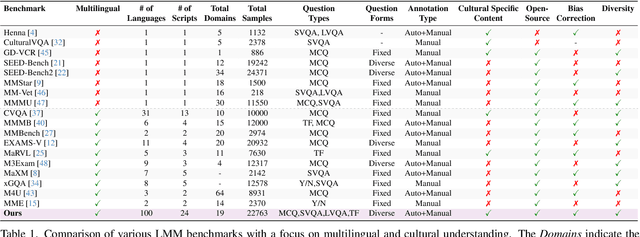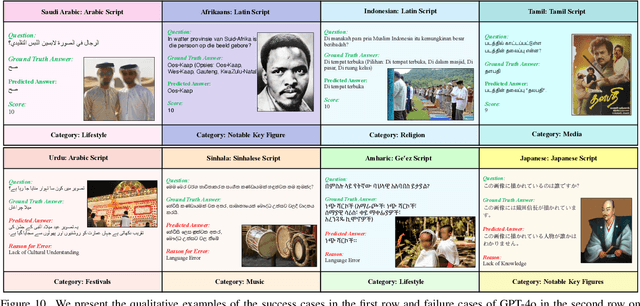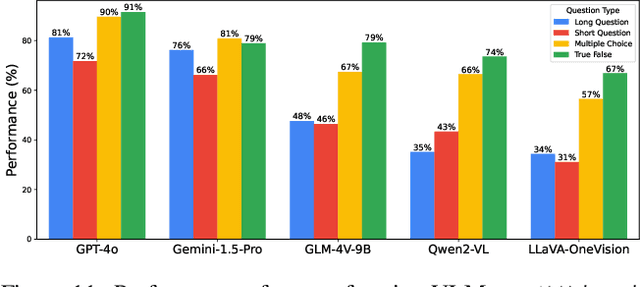Rao Muhammad Anwer
Adapting In-Domain Few-Shot Segmentation to New Domains without Retraining
Apr 30, 2025Abstract:Cross-domain few-shot segmentation (CD-FSS) aims to segment objects of novel classes in new domains, which is often challenging due to the diverse characteristics of target domains and the limited availability of support data. Most CD-FSS methods redesign and retrain in-domain FSS models using various domain-generalization techniques, which are effective but costly to train. To address these issues, we propose adapting informative model structures of the well-trained FSS model for target domains by learning domain characteristics from few-shot labeled support samples during inference, thereby eliminating the need for retraining. Specifically, we first adaptively identify domain-specific model structures by measuring parameter importance using a novel structure Fisher score in a data-dependent manner. Then, we progressively train the selected informative model structures with hierarchically constructed training samples, progressing from fewer to more support shots. The resulting Informative Structure Adaptation (ISA) method effectively addresses domain shifts and equips existing well-trained in-domain FSS models with flexible adaptation capabilities for new domains, eliminating the need to redesign or retrain CD-FSS models on base data. Extensive experiments validate the effectiveness of our method, demonstrating superior performance across multiple CD-FSS benchmarks.
Tracking Meets Large Multimodal Models for Driving Scenario Understanding
Mar 18, 2025Abstract:Large Multimodal Models (LMMs) have recently gained prominence in autonomous driving research, showcasing promising capabilities across various emerging benchmarks. LMMs specifically designed for this domain have demonstrated effective perception, planning, and prediction skills. However, many of these methods underutilize 3D spatial and temporal elements, relying mainly on image data. As a result, their effectiveness in dynamic driving environments is limited. We propose to integrate tracking information as an additional input to recover 3D spatial and temporal details that are not effectively captured in the images. We introduce a novel approach for embedding this tracking information into LMMs to enhance their spatiotemporal understanding of driving scenarios. By incorporating 3D tracking data through a track encoder, we enrich visual queries with crucial spatial and temporal cues while avoiding the computational overhead associated with processing lengthy video sequences or extensive 3D inputs. Moreover, we employ a self-supervised approach to pretrain the tracking encoder to provide LMMs with additional contextual information, significantly improving their performance in perception, planning, and prediction tasks for autonomous driving. Experimental results demonstrate the effectiveness of our approach, with a gain of 9.5% in accuracy, an increase of 7.04 points in the ChatGPT score, and 9.4% increase in the overall score over baseline models on DriveLM-nuScenes benchmark, along with a 3.7% final score improvement on DriveLM-CARLA. Our code is available at https://github.com/mbzuai-oryx/TrackingMeetsLMM
DriveLMM-o1: A Step-by-Step Reasoning Dataset and Large Multimodal Model for Driving Scenario Understanding
Mar 13, 2025Abstract:While large multimodal models (LMMs) have demonstrated strong performance across various Visual Question Answering (VQA) tasks, certain challenges require complex multi-step reasoning to reach accurate answers. One particularly challenging task is autonomous driving, which demands thorough cognitive processing before decisions can be made. In this domain, a sequential and interpretive understanding of visual cues is essential for effective perception, prediction, and planning. Nevertheless, common VQA benchmarks often focus on the accuracy of the final answer while overlooking the reasoning process that enables the generation of accurate responses. Moreover, existing methods lack a comprehensive framework for evaluating step-by-step reasoning in realistic driving scenarios. To address this gap, we propose DriveLMM-o1, a new dataset and benchmark specifically designed to advance step-wise visual reasoning for autonomous driving. Our benchmark features over 18k VQA examples in the training set and more than 4k in the test set, covering diverse questions on perception, prediction, and planning, each enriched with step-by-step reasoning to ensure logical inference in autonomous driving scenarios. We further introduce a large multimodal model that is fine-tuned on our reasoning dataset, demonstrating robust performance in complex driving scenarios. In addition, we benchmark various open-source and closed-source methods on our proposed dataset, systematically comparing their reasoning capabilities for autonomous driving tasks. Our model achieves a +7.49% gain in final answer accuracy, along with a 3.62% improvement in reasoning score over the previous best open-source model. Our framework, dataset, and model are available at https://github.com/ayesha-ishaq/DriveLMM-o1.
LLMVoX: Autoregressive Streaming Text-to-Speech Model for Any LLM
Mar 06, 2025Abstract:Recent advancements in speech-to-speech dialogue systems leverage LLMs for multimodal interactions, yet they remain hindered by fine-tuning requirements, high computational overhead, and text-speech misalignment. Existing speech-enabled LLMs often degrade conversational quality by modifying the LLM, thereby compromising its linguistic capabilities. In contrast, we propose LLMVoX, a lightweight 30M-parameter, LLM-agnostic, autoregressive streaming TTS system that generates high-quality speech with low latency, while fully preserving the capabilities of the base LLM. Our approach achieves a significantly lower Word Error Rate compared to speech-enabled LLMs, while operating at comparable latency and UTMOS score. By decoupling speech synthesis from LLM processing via a multi-queue token streaming system, LLMVoX supports seamless, infinite-length dialogues. Its plug-and-play design also facilitates extension to various tasks with different backbones. Furthermore, LLMVoX generalizes to new languages with only dataset adaptation, attaining a low Character Error Rate on an Arabic speech task. Additionally, we have integrated LLMVoX with a Vision-Language Model to create an omni-model with speech, text, and vision capabilities, without requiring additional multimodal training. Our code base and project page is available at https://mbzuai-oryx.github.io/LLMVoX .
LLM Post-Training: A Deep Dive into Reasoning Large Language Models
Feb 28, 2025Abstract:Large Language Models (LLMs) have transformed the natural language processing landscape and brought to life diverse applications. Pretraining on vast web-scale data has laid the foundation for these models, yet the research community is now increasingly shifting focus toward post-training techniques to achieve further breakthroughs. While pretraining provides a broad linguistic foundation, post-training methods enable LLMs to refine their knowledge, improve reasoning, enhance factual accuracy, and align more effectively with user intents and ethical considerations. Fine-tuning, reinforcement learning, and test-time scaling have emerged as critical strategies for optimizing LLMs performance, ensuring robustness, and improving adaptability across various real-world tasks. This survey provides a systematic exploration of post-training methodologies, analyzing their role in refining LLMs beyond pretraining, addressing key challenges such as catastrophic forgetting, reward hacking, and inference-time trade-offs. We highlight emerging directions in model alignment, scalable adaptation, and inference-time reasoning, and outline future research directions. We also provide a public repository to continually track developments in this fast-evolving field: https://github.com/mbzuai-oryx/Awesome-LLM-Post-training.
CLIMB-3D: Continual Learning for Imbalanced 3D Instance Segmentation
Feb 24, 2025Abstract:While 3D instance segmentation has made significant progress, current methods struggle to address realistic scenarios where new categories emerge over time with natural class imbalance. This limitation stems from existing datasets, which typically feature few well-balanced classes. Although few datasets include unbalanced class annotations, they lack the diverse incremental scenarios necessary for evaluating methods under incremental settings. Addressing these challenges requires frameworks that handle both incremental learning and class imbalance. However, existing methods for 3D incremental segmentation rely heavily on large exemplar replay, focusing only on incremental learning while neglecting class imbalance. Moreover, frequency-based tuning for balanced learning is impractical in these setups due to the lack of prior class statistics. To overcome these limitations, we propose a framework to tackle both \textbf{C}ontinual \textbf{L}earning and class \textbf{Imb}alance for \textbf{3D} instance segmentation (\textbf{CLIMB-3D}). Our proposed approach combines Exemplar Replay (ER), Knowledge Distillation (KD), and a novel Imbalance Correction (IC) module. Unlike prior methods, our framework minimizes ER usage, with KD preventing forgetting and supporting the IC module in compiling past class statistics to balance learning of rare classes during incremental updates. To evaluate our framework, we design three incremental scenarios based on class frequency, semantic similarity, and random grouping that aim to mirror real-world dynamics in 3D environments. Experimental results show that our proposed framework achieves state-of-the-art performance, with an increase of up to 16.76\% in mAP compared to the baseline. Code will be available at: \href{https://github.com/vgthengane/CLIMB3D}{https://github.com/vgthengane/CLIMB3D}
Time Travel: A Comprehensive Benchmark to Evaluate LMMs on Historical and Cultural Artifacts
Feb 20, 2025Abstract:Understanding historical and cultural artifacts demands human expertise and advanced computational techniques, yet the process remains complex and time-intensive. While large multimodal models offer promising support, their evaluation and improvement require a standardized benchmark. To address this, we introduce TimeTravel, a benchmark of 10,250 expert-verified samples spanning 266 distinct cultures across 10 major historical regions. Designed for AI-driven analysis of manuscripts, artworks, inscriptions, and archaeological discoveries, TimeTravel provides a structured dataset and robust evaluation framework to assess AI models' capabilities in classification, interpretation, and historical comprehension. By integrating AI with historical research, TimeTravel fosters AI-powered tools for historians, archaeologists, researchers, and cultural tourists to extract valuable insights while ensuring technology contributes meaningfully to historical discovery and cultural heritage preservation. We evaluate contemporary AI models on TimeTravel, highlighting their strengths and identifying areas for improvement. Our goal is to establish AI as a reliable partner in preserving cultural heritage, ensuring that technological advancements contribute meaningfully to historical discovery. Our code is available at: \url{https://github.com/mbzuai-oryx/TimeTravel}.
LlamaV-o1: Rethinking Step-by-step Visual Reasoning in LLMs
Jan 10, 2025



Abstract:Reasoning is a fundamental capability for solving complex multi-step problems, particularly in visual contexts where sequential step-wise understanding is essential. Existing approaches lack a comprehensive framework for evaluating visual reasoning and do not emphasize step-wise problem-solving. To this end, we propose a comprehensive framework for advancing step-by-step visual reasoning in large language models (LMMs) through three key contributions. First, we introduce a visual reasoning benchmark specifically designed to evaluate multi-step reasoning tasks. The benchmark presents a diverse set of challenges with eight different categories ranging from complex visual perception to scientific reasoning with over 4k reasoning steps in total, enabling robust evaluation of LLMs' abilities to perform accurate and interpretable visual reasoning across multiple steps. Second, we propose a novel metric that assesses visual reasoning quality at the granularity of individual steps, emphasizing both correctness and logical coherence. The proposed metric offers deeper insights into reasoning performance compared to traditional end-task accuracy metrics. Third, we present a new multimodal visual reasoning model, named LlamaV-o1, trained using a multi-step curriculum learning approach, where tasks are progressively organized to facilitate incremental skill acquisition and problem-solving. The proposed LlamaV-o1 is designed for multi-step reasoning and learns step-by-step through a structured training paradigm. Extensive experiments show that our LlamaV-o1 outperforms existing open-source models and performs favorably against close-source proprietary models. Compared to the recent Llava-CoT, our LlamaV-o1 achieves an average score of 67.3 with an absolute gain of 3.8\% across six benchmarks while being 5 times faster during inference scaling. Our benchmark, model, and code are publicly available.
All Languages Matter: Evaluating LMMs on Culturally Diverse 100 Languages
Nov 25, 2024



Abstract:Existing Large Multimodal Models (LMMs) generally focus on only a few regions and languages. As LMMs continue to improve, it is increasingly important to ensure they understand cultural contexts, respect local sensitivities, and support low-resource languages, all while effectively integrating corresponding visual cues. In pursuit of culturally diverse global multimodal models, our proposed All Languages Matter Benchmark (ALM-bench) represents the largest and most comprehensive effort to date for evaluating LMMs across 100 languages. ALM-bench challenges existing models by testing their ability to understand and reason about culturally diverse images paired with text in various languages, including many low-resource languages traditionally underrepresented in LMM research. The benchmark offers a robust and nuanced evaluation framework featuring various question formats, including true/false, multiple choice, and open-ended questions, which are further divided into short and long-answer categories. ALM-bench design ensures a comprehensive assessment of a model's ability to handle varied levels of difficulty in visual and linguistic reasoning. To capture the rich tapestry of global cultures, ALM-bench carefully curates content from 13 distinct cultural aspects, ranging from traditions and rituals to famous personalities and celebrations. Through this, ALM-bench not only provides a rigorous testing ground for state-of-the-art open and closed-source LMMs but also highlights the importance of cultural and linguistic inclusivity, encouraging the development of models that can serve diverse global populations effectively. Our benchmark is publicly available.
AgroGPT: Efficient Agricultural Vision-Language Model with Expert Tuning
Oct 10, 2024Abstract:Significant progress has been made in advancing large multimodal conversational models (LMMs), capitalizing on vast repositories of image-text data available online. Despite this progress, these models often encounter substantial domain gaps, hindering their ability to engage in complex conversations across new domains. Recent efforts have aimed to mitigate this issue, albeit relying on domain-specific image-text data to curate instruction-tuning data. However, many domains, such as agriculture, lack such vision-language data. In this work, we propose an approach to construct instruction-tuning data that harnesses vision-only data for the agriculture domain. We utilize diverse agricultural datasets spanning multiple domains, curate class-specific information, and employ large language models (LLMs) to construct an expert-tuning set, resulting in a 70k expert-tuning dataset called AgroInstruct. Subsequently, we expert-tuned and created AgroGPT, an efficient LMM that can hold complex agriculture-related conversations and provide useful insights. We also develop AgroEvals for evaluation and compare {AgroGPT's} performance with large open and closed-source models. {AgroGPT} excels at identifying fine-grained agricultural concepts, can act as an agriculture expert, and provides helpful information for multimodal agriculture questions. The code, datasets, and models are available at https://github.com/awaisrauf/agroGPT.
 Add to Chrome
Add to Chrome Add to Firefox
Add to Firefox Add to Edge
Add to Edge